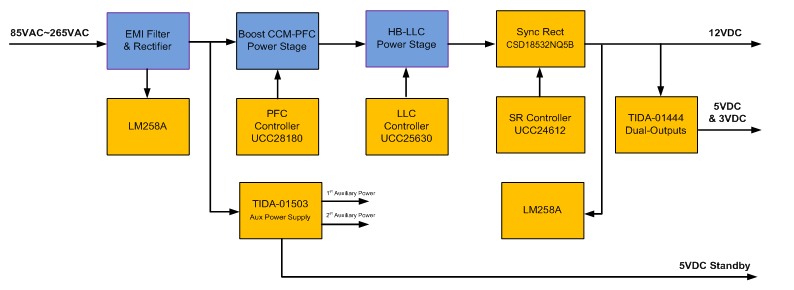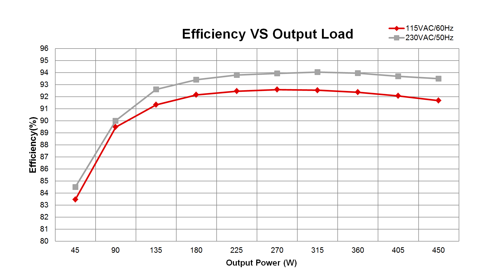SSZT909 october 2017 UCC256301 , UCC28180
A desktop power-supply unit (PSU) usually consists of a front-end power factor correction (PFC) stage and an isolated DC/DC stage. In the 80+ Platinum, 93% Efficiency, Super Transient 450W AC/DC Reference Design with Single-Layer PCB, the circuit consists of a continuous-conduction-mode PFC stage (the UCC28180 PFC controller) and a half-bridge resonant inductor-inductor-capacitor (LLC) stage (the UCC256301 LLC controller) to realize the 450W AC/DC power conversion.
 Figure 1 Desktop Power Supply Design
Block Diagram
Figure 1 Desktop Power Supply Design
Block DiagramCompared with a multi-layer PCB solution, there are several advantages to a single-layer solution. The most significant advantage is the lower cost. This cost-effective design uses a low-cost, single-layer solution on the main board that helps reduce overall system cost, an important factor in the competitive desktop PSU market. Another advantage is the lower probability of manufacturing issues and potentially shorter manufacturing time, which is very common during the mass production of desktop PSUs.
High efficiency is another important feature for the TIDA-01501. For the PFC stage, the PFC inductor uses a ferrite core to obtain lower core losses than a powder core. The parallel winding method of the multistring litz wire improves skin and proximity effects and also decreases eddy current loss, thereby achieving lower copper loss. For the half-bridge LLC stage, the secondary-side winding of the transformer uses a copper sheet (replacing the traditional copper wire) to sustain the secondary large flowing current, and the winding structure greatly enhances the space-filling coefficient of the transformer. Also, a fully interleaved structure decreases the AC losses. In addition, the LLC primary switch operates in zero voltage switching (ZVS) mode and the secondary switch operate in zero current switching (ZCS) mode, which greatly reduces the switching loss. Figure 2 shows the efficiency curve of the overall PSU.
 Figure 2 Overall PSU Efficiency
Curve
Figure 2 Overall PSU Efficiency
CurveThe TIDA-01501 provides a reference for how a single-layer solution can help you accomplish high efficiency at a low overall cost to the system, which is the key to the competitive high-volume desktop PSU market. You can easily make your design reach the 80 Plus platinum efficiency level with single layer PCB.
Additional Resources
- Read up on how the UCC256301 can improve the power supply for your desktop PSU
- Learn how to improve the efficiency of your UPS design